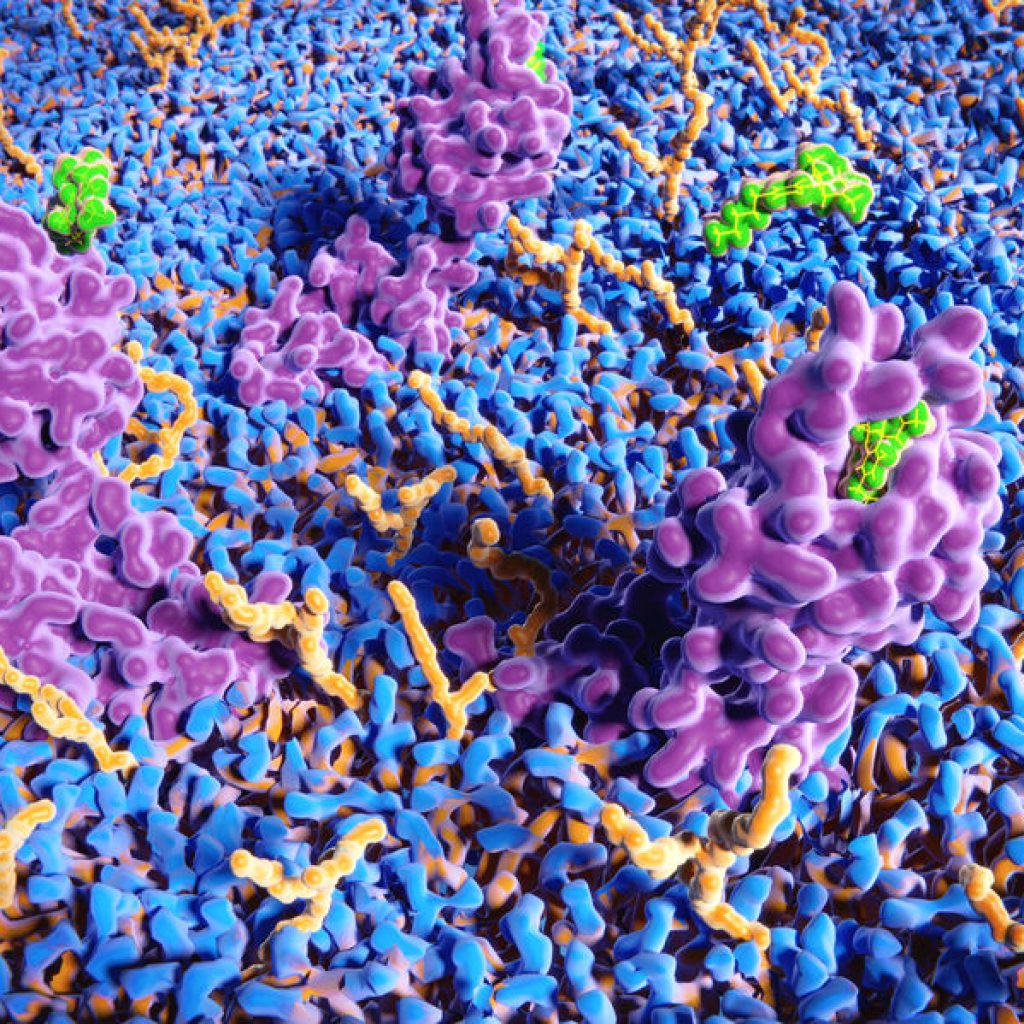JAKE F. FELICE, ND, LMP
The endocannabinoid system (ECS) responds not only to cannabis and cannabinoid molecules; it is also positively affected by diet, exercise, acupuncture, probiotics, prebiotics, acupuncture, osteopathic manipulation, and mind-body medicine, as well as other non-cannabis botanicals and complementary and alternative medicine (CAM) therapies.1 The ECS thus offers 21st-century clinicians unique opportunities to explore the efficacy of various natural therapeutic modalities, and it gives modern clinicians invaluable mechanisms by which to unify our most current biochemical discoveries with traditional naturopathic and CAM modalities.
The ECS is intimately involved in homeostasis, functioning as a self-regulating, harm-reduction system. It profoundly influences a multitude of physiologic processes in the human body and in almost all other mammals. The ECS consists of cannabinoid receptors CB1 and CB2, endogenous ligands known as endocannabinoids (including their transport mechanisms), and the endocannabinoid-metabolizing enzymes anandamide (AEA) and 2-arachidonoylglycerol (2-AG).
Stress puts strain on all health maintenance systems, including the hypothalamic-pituitary-adrenal axis (HPA) and the endocannabinoid system. Stress-related imbalances contribute to depression, obesity, affective disorders, cardiovascular disease, substance abuse, and many other conditions.2 In humans, stress exposure triggers complex multisystem cellular events involving hormones and autonomic responses. When the body’s stress responses are compromised or excessive, the complexity of maintaining homeostasis builds, putting individuals at increased risk for stress-related diseases. It is well known that certain individuals are more resilient to the effects of stress than others, as not all people exposed to the same stressors develop the same symptoms. What makes some people resilient to stress while others remain more susceptible? By better comprehending neurobiologic and physiologic resiliencies to stress, clinicians can more effectively interpret and develop therapies that increase human adaptability while at the same time helping to reduce the prevalence of stress-induced disease.
By understanding the nature of ECS signaling, clinicians may gain insight into this system as a potential therapeutic target for the treatment of stress-related disorders. A large and growing body of evidence supports a role for the ECS in healthy stress responses. Chronic stress impedes the effectiveness of the ECS, and a healthy ECS is required for a properly functioning HPA. Animal studies have shown that the body’s endocannabinoids modulate the ECS in a context-dependent manner, reinforcing the concept of endocannabinoid tone.3-5 It appears that baseline endocannabinoid tone both affects and is affected by stress.5
ECS Receptors Within the HPA Axis
Cannabinoid CB1 receptors are present in limbic structures of the brain, as well as in the paraventricular nucleus (PVN) of the hypothalamus, both of which are involved in the stress response.6 Additionally, both CB1 receptors and endocannabinoids are present in the human pituitary gland and in high concentration in the adrenal glands.7,8
Animal data suggest that deficient CB1 signaling in the hippocampus contributes to adverse cognitive and memory changes resulting from chronic stress. For example, mice subjected to a Morris Water Maze stress test showed stress-induced cognitive impairments and slower learning compared to controls.9 These deficits were reversed when a CB1 agonist was administered to the mice. In addition to the ECS’ influence on stress via the hypothalamus, the ECS was shown in mice to influence the HPA axis via cannabinoid receptors in the pituitary.10 In another study, a lack of cannabinoid receptors in CB1 knockout mice results not only in increased anxiety-like behaviors compared to controls, but also an inferior response to anxiolytic drugs.11
Stress & the ECS
ECS feedback interacts directly with the HPA axis via the endocannabinoids AEA and 2-AG.12,13 Interestingly, human and animal models suggest that interactions between the ECS and the stress response are bidirectional.12,13 Stress influences the ECS, and ECS mechanisms alter stress responses.14 As a biologic informational system, the bidirectionality of the ECS is ideally suited to convey feedback information to the body, helping it to adjust to both acute and chronic stressors.
A properly functioning ECS is thus essential for HPA coordination, while an impaired ECS generates significant dysregulation of HPA functioning. Cortisol levels in CB1 knockout mice are almost double the levels of cortisol in wild-type mice possessing competent cannabinoid receptors.10 The wild-type mice receiving low-dose dexamethasone showed decreased ACTH and cortisol levels, whereas the CB1 knockout mice showed increased ACTH but no reduction in cortisol levels. Additionally, the CB1 knockout mice showed increased levels of corticotropin-releasing factor (CRF) in the PVN of the hypothalamus as compared to the wild-type mice.10 These findings suggest that the functionality of CB1 receptors directly determines the physiologic response to negative feedback within the HPA axis.
The accumulating research supports the argument that improvements in ECS signaling help modulate stress-induced HPA responses.5 During stressful events, glucocorticoids mobilize the ECS through activation of the endocannabinoid 2-AG.13 Meanwhile, many of the effects of glucocorticoids, including HPA feedback signaling, require the activation of CB1 receptors.13
Repeated stress promotes ECS activation by augmenting the body’s endocannabinoid production, which correspondingly downregulates stress responses.15,16 In a mouse study, the effects of repetitive restraint-stress was shown to alter endocannabinoid levels in a regionally and ligand-dependent fashion.4 It stands to reason that the subsequent degradation of the ECS from the ravages of chronic stress may be strongly associated with the induction of stress-related illnesses.
Under situations of chronic stress, the HPA axis can become habituated to produce a reduced biologic response to stress, including decreased hormonal responses. Evidence now indicates that an intact ECS is essential for the induction of stress habituation. For example, blockage of the CB1 receptor by an antagonist in the prefrontal cortex of mice exposed to the repeated stress of restraint reduces stress habituation in the animals.15
Acute Stress
Stress causes elevation of cortisol levels and significantly impacts the ECS. During acute stress, the ECS scales down, thereby decreasing the impact of the body’s HPA hormone cascade.17 In mouse models, inhibition of ECS activity has been demonstrated to increase HPA activation, whereas enhancement of the ECS inhibits HPA activation.15,18 Acute stress in mice tends to alter stress-based behaviors such as increasing defensive postures and reducing pleasure seeking. ECS signaling has been shown to modulate this behavioral effect of stress.19-21
Chronic Stress
Following a stress response, negative feedback mechanisms normally dampen cortisol output. These mechanisms serve to safeguard the physiology from harm caused by a chronic excess of glucocorticoids. Similar to conditions of acute stress, animal models have demonstrated that ESC signaling is associated with both reduced basal and induced stress responses within the HPA, while a disruption in CB1 receptor signaling is associated with an overactivation of the HPA axis – actions that may be mediated centrally rather than at the level of the pituitary.22
When rodents are exposed randomly to chronic mild stress (CMS), physiologic changes occur that are highly specific and predictive of depression.23 In rat models, exposure to CMS decreases CB1 receptors in the hippocampus12 while at the same time increasing them in the prefrontal cortex, an action that is mirrored by the pharmacologically induced stress cascade that results from long-term steroid treatment.24,25
In a human study, healthy participants subjected to the stress of social isolation and confinement for 520 days – a study designed to mimic space travel to Mars – showed reduced ECS functioning.26 In this study, blood concentrations of the endocannabinoid 2-AG were significantly reduced in study participants, suggesting that poor ECS function “might be specifically implicated in the response to chronic stressors.” Authors of this study observed “reduced positive emotion ratings, decreased brain cortical activities and high levels of catecholamine release, indicating that prolonged exposure to isolation and confinement stressors may bring about changes both psychologically and physiologically.”26
In a population-based cohort study, individuals with post-traumatic stress disorder (PTSD) who survived the World Trade Center attacks showed significantly lower levels of 2-AG compared to controls who were near the attacks but who did not develop PTSD.27 Another study found reduced levels of both 2-AG and AEA in women with major depression, as compared to female controls.28
Conclusion
ECS signaling within the HPA axis can be understood by thinking of the ECS as a regulator of the endocrine response to stress, acting to either dampen the stress response or to potentiate it via the release of CRF and glucocorticoids. In today’s modern world, humans frequently encounter multiple daily stressors that can contribute to anxiety, insomnia, depression, obesity, autoimmune disease, cardiovascular diseases, and more. A balanced ECS, achieved through naturopathic and CAM modalities, will support patients who face these daily chronic stressors, potentially providing increased quality of life, improved stress response, and favorably impacting the effect of chronic stress on stress-related disorders.
References:
- McPartland JM, Guy GW, di Marzo V. Care and feeding of the endocannabinoid system: A systematic review of potential clinical interventions that upregulate the endocannabinoid system. PLoS One. 2014;9(3):e89566.
- American Psychological Association. Stress effects on the body. November 1, 2018. Available at: https://www.apa.org/topics/stress-body. Accessed December 19, 2020.
- Manzanares J, Corchero J, Fuentes JA. Opioid and cannabinoid receptor-mediated regulation of the increase in adrenocorticotropin hormone and corticosterone plasma concentrations induced by central administration of delta(9)-tetrahydrocannabinol in rats. Brain Res. 1999;839(1):173-179.
- Patel S, Roelke CT, Rademacher DJ, et al. Endocannabinoid signaling negatively modulates stress-induced activation of the hypothalamic-pituitary-adrenal axis. Endocrinology. 2004;145(12):5431-5438.
- Gorzalka BB, Hill MN. Integration of endocannabinoid signaling into the neural network regulating stress-induced activation of the hypothalamic-pituitary-adrenal axis. Curr Top Behav Neurosci. 2009;1:289-306.
- Herkenham M, Lynn AB, Johnson MR, et al. Characterization and localization of cannabinoid receptors in rat brain: A quantitative in vitro autoradiographic study. J Neurosci. 1991;11(2):563-583.
- Pagotto U, Marsicano G, Cota D, et al. The emerging role of the endocannabinoid system in endocrine regulation and energy balance. Endocr Rev. 2006;27(1):73-100.
- Galiègue S, Mary S, Marchand J, et al. Expression of Central and Peripheral Cannabinoid Receptors in Human Immune Tissues and Leukocyte Subpopulations. Eur J Biochem. 1995;232(1):54-61.
- Hill MN, Patel S, Carrier EJ, et al. Downregulation of endocannabinoid signaling in the hippocampus following chronic unpredictable stress. Neuropsychopharmacology. 2005;30(3):508-515.
- Cota D, Steiner MA, Marsicano G, et al. Requirement of cannabinoid receptor type 1 for the basal modulation of hypothalamic-pituitary-adrenal axis function. Endocrinology. 2007;148(4):1574-1581.
- Urigüen L, Pérez-Rial S, Ledent C, et al. Impaired action of anxiolytic drugs in mice deficient in cannabinoid CB1 receptors. Neuropharmacology. 2004;46(7):966-973.
- Hill MN, Carrier EJ, Ho WS, et al. Prolonged glucocorticoid treatment decreases cannabinoid CB1 receptor density in the hippocampus. Hippocampus. 2008;18(2):221-226.
- Hillard CJ, Beatka M, Sarvaideo J. Endocannabinoid signaling and the hypothalamic-pituitary-adrenal axis. Compr Physiol. 2017;7(1):1-15.
- Di S, Malcher-Lopes R, Halmos KC, Tasker JG. Nongenomic glucocorticoid inhibition via endocannabinoid release in the hypothalamus: A fast feedback mechanism. J Neurosci. 2003;23(12):4850-4857.
- Patel S, Roelke CT, Rademacher DJ, Hillard CJ. Inhibition of restraint stress-induced neural and behavioural activation by endogenous cannabinoid signalling. Eur J Neurosci. 2005;21(4):1057-1069.
- Rademacher DJ, Meier SE, Shi L, et al. Effects of acute and repeated restraint stress on endocannabinoid content in the amygdala, ventral striatum, and medial prefrontal cortex in mice. Neuropharmacology. 2008;54(1):108-116.
- Gorzalka BB, Hill MN, Hillard CJ. Regulation of endocannabinoid signaling by stress: Implications for stress-related affective disorders. Neurosci Biobehav Rev. 2008;32(6):1152-1160.
- Haller J, Varga B, Ledent C, et al. Context-dependent effects of CB1 cannabinoid gene disruption on anxiety-like and social behaviour in mice. Eur J Neurosci. 2004;19(7):1906-1912.
- Hill MN, Tasker JG. Endocannabinoid signaling, glucocorticoid-mediated negative feedback, and regulation of the hypothalamic-pituitary-adrenal axis. Neuroscience. 2012;204:5-16.
- Patel S, Hillard CJ. Pharmacological evaluation of cannabinoid receptor ligands in a mouse model of anxiety: Further evidence for an anxiolytic role for endogenous cannabinoid signaling. J Pharmacol Exp Ther. 2006;318(1):304-311.
- Rademacher DJ, Hillard CJ. Interactions between endocannabinoids and stress-induced decreased sensitivity to natural reward. Prog Neuropsychopharmacol Biol Psychiatry. 2007;31(3):633-641.
- Barna I, Zelena D, Arszovszki AC, Ledent C. The role of endogenous cannabinoids in the hypothalamo-pituitary-adrenal axis regulation: In vivo and in vitro studies in CB1 receptor knockout mice. Life Sci. 2004;75(24):2959-2970.
- Bortolato M, Mangieri RA, Fu J, et al. Antidepressant-like Activity of the Fatty Acid Amide Hydrolase Inhibitor URB597 in a Rat Model of Chronic Mild Stress. Biol Psychiatry. 2007;62(10):1103-1110.
- Dominguez G, Faucher P, Henkous N, et al. Stress induced a shift from dorsal hippocampus to prefrontal cortex dependent memory retrieval: role of regional corticosterone. Front Behav Neurosci. 2014;8:166.
- McLaughlin RJ, Hill MN, Dang SS, et al. Upregulation of CB₁ receptor binding in the ventromedial prefrontal cortex promotes proactive stress-coping strategies following chronic stress exposure. Behav Brain Res. 2013;237:333-337.
- Yi B, Nichiporuk I, Nicolas M, et al. Reductions in circulating endocannabinoid 2-arachidonoylglycerol levels in healthy human subjects exposed to chronic stressors. Prog Neuropsychopharmacol Biol Psychiatry. 2016;67:92-97.
- Hill MN, Bierer LM, Makotkine I, et al. Reductions in circulating endocannabinoid levels in individuals with post-traumatic stress disorder following exposure to the world trade center attacks. Psychoneuroendocrinology. 2013;38(12):2952-2961.
- Hill MN, Miller GE, Carrier EJ, et al. Circulating endocannabinoids and N-acyl ethanolamines are differentially regulated in major depression and following exposure to social stress. Psychoneuroendocrinology. 2009;34(8):1257-1262.

Jake F. Felice, ND, LMP is a cannabis author, clinician, and educator whose vision is to advance the science and practical application of medical cannabis for medical and recreational markets around the world. Dr Felice provides world class cannabis education experiences by speaking authentically about hemp and cannabis. He consults with healthcare providers and the general public. His Category-1 CME courses for doctors, nurses, and pharmacists have now been translated into 4 languages. Dr Felice is the founder of Cannabis Matrix Consulting, LLC, and he maintains a regular cannabis blog at drjakefelice.com.





